
Edgar Allan Poe was an American writer, poet, author, editor, and literary critic who is best known for his poetry and short stories, particularly his tales of mystery and the macabre. He is widely regarded as a central figure of Romanticism and Gothic fiction in the United States, and of American literature. Poe was one of the country's earliest practitioners of the short story, and is considered the inventor of the detective fiction genre, as well as a significant contributor to the emerging genre of science fiction. He is the first well-known American writer to earn a living through writing alone, resulting in a financially difficult life and career.

Visual art of the United States or American art is visual art made in the United States or by U.S. artists. Before colonization, there were many flourishing traditions of Native American art, and where the Spanish colonized Spanish Colonial architecture and the accompanying styles in other media were quickly in place. Early colonial art on the East Coast initially relied on artists from Europe, with John White the earliest example. In the late 18th and early 19th centuries, artists primarily painted portraits, and some landscapes in a style based mainly on English painting. Furniture-makers imitating English styles and similar craftsmen were also established in the major cities, but in the English colonies, locally made pottery remained resolutely utilitarian until the 19th century, with fancy products imported.
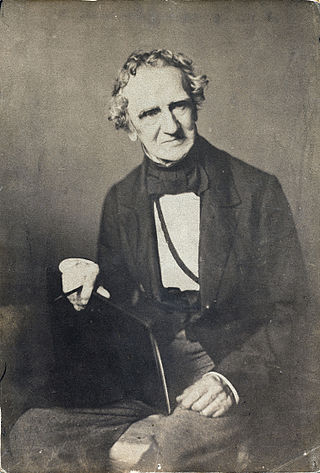
Thomas Sully was an American portrait painter in the United States. Born in Great Britain, he lived most of his life in Philadelphia, Pennsylvania. He painted in the style of Thomas Lawrence. His subjects included national political leaders such as United States presidents: Thomas Jefferson, John Quincy Adams, and Andrew Jackson, Revolutionary War hero General Marquis de Lafayette, and many leading musicians and composers. In addition to portraits of wealthy patrons, he painted landscapes and historical pieces such as the 1819 The Passage of the Delaware. His work was adapted for use on United States coinage.

George Richmond was an English painter and portraitist. In his youth he was a member of The Ancients, a group of followers of William Blake. Later in life he established a career as a portrait painter, which included painting the portraits of the British gentry, nobility and royalty.

George Peter Alexander Healy was an American portrait painter. He was one of the most prolific and popular painters of his day, and his sitters included many of the eminent personages of his time. Born in Boston, he studied in Europe, and over his lifetime had studios in Paris and Chicago.
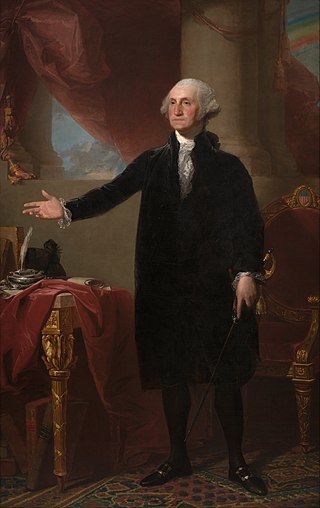
The Lansdowne portrait is an iconic life-size portrait of George Washington painted by Gilbert Stuart in 1796. It depicts the 64-year-old President of the United States during his final year in office. The portrait was a gift to former British Prime Minister William Petty, 1st Marquess of Lansdowne, and spent more than 170 years in England.
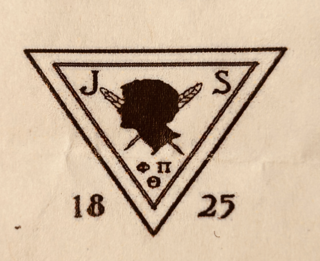
The Jefferson Literary and Debating Society is the oldest continuously existing collegiate debating society in North America. The society was founded on July 14, 1825, in Room Seven, West Lawn at the University of Virginia. Named for founder of the University, Thomas Jefferson, the society regularly meets on Friday evenings at "The Hall" in the Lawn.

Richard Bland Lee was an American planter, jurist, and politician from Fairfax County, Virginia. He was the son of Henry Lee II (1730–1787) of "Leesylvania" and Lucy Grymes (1734–1792), as well as a younger brother of both Maj. Gen. Henry Lee (1756–1818) and of Charles Lee (1758–1815), Attorney General of the United States from 1795 to 1801, who served in both the Washington and Adams administrations.

Joseph Henry Sharp was an American painter and a founding member of the Taos Society of Artists, of which he is considered the "Spiritual Father". Sharp was one of the earliest European-American artists to visit Taos, New Mexico, which he saw in 1893 with artist John Hauser. He painted American Indian portraits and cultural life, as well as Western landscapes. President Theodore Roosevelt commissioned him to paint the portraits of 200 Native American warriors who survived the Battle of the Little Bighorn. While working on this project, Sharp lived on land of the Crow Agency, Montana, where he built Absarokee Hut in 1905. Boosted by his sale of 80 paintings to Phoebe Hearst, Sharp quit teaching and began to paint full-time.

The death of Edgar Allan Poe on October 7, 1849, has remained mysterious in regard to both the cause of death and the circumstances leading to it. American author Edgar Allan Poe was found delirious and disheveled at a tavern in Baltimore, Maryland, on October 3. He sought the help of magazine editor Joseph E. Snodgrass and was taken to the Washington College Hospital, where he was treated for apparent intoxication. Poe had no visitors in the hospital and gave no account of how he came to be in his condition before dying on October 7 at age 40.
"The Philosophy of Furniture" is an essay written by American author Edgar Allan Poe and published in 1840. The essay is an unusual work by Poe, whose better-known works include horror tales like "The Tell-Tale Heart". The essay presents Poe's theories on interior decorating.
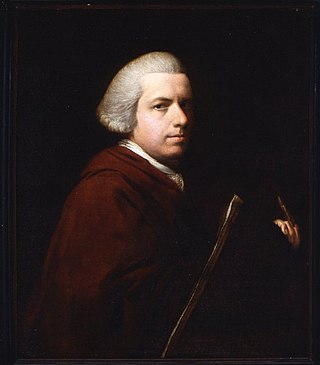
Henry Benbridge was an early American portrait painter.

John Neagle was a fashionable American painter, primarily of portraits, during the first half of the 19th century in Philadelphia.

William Dickinson Washington was an American painter and teacher of art. He is most famous for his painting The Burial of Latané, which became a symbol of the Lost Cause of the Confederacy in the years following the American Civil War, and for the work he did in establishing the fine arts program of the Virginia Military Institute.

John Wollaston was an English painter of portraits who was active in the British colonies in North America for much of his career. He was one of a handful of painters to introduce the English Rococo style to the American colonies.
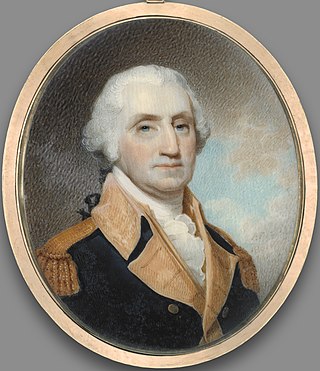
Robert Field (1769–1819) was a painter who was born in London and died in Kingston, Jamaica. According to art historian Daphne Foskett, author of A Dictionary of British Miniature Painters (1972), Field was "one of the best American miniaturists of his time." During Field's time in Nova Scotia at the beginning of the nineteenth century, he was the most professionally trained painter in present-day Canada. He worked in the conventional neo-classic portrait style of Henry Raeburn and Gilbert Stuart. His most famous works are two groups of miniatures of George Washington, commissioned by his wife Martha Washington.

James Bowman was an American itinerant artist and portrait painter. He was born in Allegheny County, Pennsylvania near Pittsburgh. Sometime between 1813 and 1815, James Bowman went to Chillicothe, Ohio, to learn to be a carpenter. There he met the itinerant painter Mr. J. T. Turner who taught him the rudiments of portrait painting. He gained considerable success when he started out professionally, painting in Pittsburgh and other communities in the early 1820s. He traveled to Philadelphia to learn from the masters there, but as a beginning artist could not make a living in that more cosmopolitan and competitive environment and became an itinerant portrait painter instead.
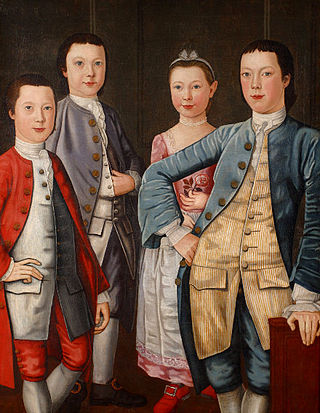
John Durand was a colonial American portraitist. With John Mare, Abraham Delanoy, and Lawrence Kilburn, he was one of a number of portraitists living and working in New York City during the 1760s.

Benjamin Trott was an American painter who specialized in portrait miniatures.

Walter Gould was an American painter; known for his Orientalist scenes. He also painted landscapes, portraits and still-lifes.




















